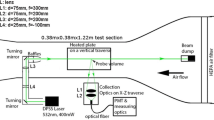Abstract
A supersonic exhaust plume test rig and a Rayleigh scattering system were developed. Molecular number densities in the supersonic high-temperature exhaust plume with and without an annular base flow were investigated. The physical meaning of the inferred mean temperature from the number density measurement in turbulent flows is clarified. For both flows, the potential core extends up to about six nozzle diameters, and self-similarity of the radial density distributions is observed at downstream sections Z/d=10–50. The recovery of the flow density deficit (or the decay of temperature) with the annular flow is faster than that without the annular flow at upstream sections Z/d ≤ 10.
Similar content being viewed by others
Author information
Authors and Affiliations
Additional information
Received: 16 August 2000 / Accepted: 20 November 2001
Rights and permissions
About this article
Cite this article
Jiang, L., Sislian, J. Rayleigh scattering in supersonic high-temperature exhaust plumes. Experiments in Fluids 32, 487–493 (2002). https://doi.org/10.1007/s00348-001-0391-6
Issue Date:
DOI: https://doi.org/10.1007/s00348-001-0391-6




